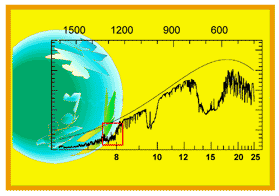
How Does Life Begin and Develop?
Goal
1
How
Life Arose on Earth
Goal
2
Organization of Matter into Living Systems
Goal
4
Coevolution of the Biosphere and the Earth
Does Life Exist Elsewhere in the Universe?
Goal
7
Signature of Life on Other Worlds
Goal
8
Life on Mars and Europa
What is Life's Future on Earth and Beyond?
Goal
9
Environmental Change on Earth
Goal
10
Terrestrial Life in Space
Question: Does Life Exist Elsewhere in the Universe?
Goal
7: Determine How
to Recognize the Signature of Life on Other Worlds

Learn to recognize extraterrestrial biospheres, by identifying structural
fossils or chemical traces of extinct life in returned samples and by
investigating what biomarkers could be detected in the spectra of planets
circling other stars.
We are poised on the brink of searching for life, past or present, on a variety of worlds. This search requires that we be able to recognize extraterrestrial biospheres and to detect the signatures of extraterrestrial life. Within our own solar system, and based on our experiences here on Earth, we must learn to recognize structural fossils or chemical traces of extinct life that may be found in extraterrestrial rocks or other samples. To understand remotely sensed information from planets circling other stars, we should develop a catalog of possible signatures of life.
Background
Today, with recent discoveries of extrasolar planets and of possible evidence for past life on Mars, the age-old question "Are we alone?" is once again in the forefront of scientific inquiry. Our search for life beyond Earth requires an ability to recognize the potential for extraterrestrial biospheres and a capacity to detect the signatures of extraterrestrial life. Within our own solar system, we must learn to recognize the fossils or other biomarkers of extinct life that may be found in returned samples. It is also essential to learn to identify the chemical signatures of life on a distant world through remote sensing of its atmosphere or surface. On Earth, life has produced easily detectable atmospheric and surface changes. These changes include high concentrations of 02 and 03 in the atmosphere and the presence of a distinctive spectral feature (due to chlorophyll) on the surface. However, these effects have been most pronounced only for the last billion years of Earth history. For the previous several billion years during which Earth had life, the atmospheric and surface signatures are not fully understood. In exploring other worlds, it is critical that we generalize the process of coevolution of planet and life (Goal 3 and Goal 4). A long-term consideration is to develop alternative methods of searching for life, such as detecting radio signals or other artifacts from an advanced civilization.